In the dark ages, people talked to each other and thereby exchanged their thoughts. The listeners passed on what they had heard – perhaps with their evaluation of what was said. As more people join forces and specialized in what they did best, content experts also evolved. They build creation myths, cultures, economic systems, and subsequently societies with a common self-image. The increasing availability of books led to different and sometimes contradictory world views. Nowadays, anybody with access to the Internet can exchange ideas with anyone else – as long as they find each other. Who would ever have expected that such increasing availability of content could become a problem?
We are now in the midst of the clash of civilizations that Samuel Huntington described in the nineties. Today, it’s all about who is in control of the truth. As in the boiling frog syndrome, the discussions between different points of view are heating up more and more. For pacification, the competing parties should be aware of the following aspects.
- We share OUR thoughts
Our brain predominantly controls our body functions and, quasi by the way, generates our consciousness. Before becoming conscious, the truths are hidden in latency. A Eureka draws our attention and the thoughts become our reality. Does the sea murmurs or do the trees rustle as long as there are no observers? Can the sea murmuring if we do not know the term murmur? Does it rustle if the trees are creaking?
Already with the choice of our words, we are moving away from the neutral position of the uninvolved observer. Whether we simply mean something or believe that we are familiar with it or entirely convinced that we know, it makes no difference to other people. In all cases, our thought is in the world. This is especially true for abstract concepts, which can only be grasped mentally. The communicated expressions can only be vaguely distinguished into knowledge, belief, or opinion. Nevertheless, we share OUR thinking – also now. - The arrogance of the bubbles
New content is added based on our existing ideas. Without the already latently available new things in our mental models, there are no points of contact and there will not be such a thing as “Oh, I see”. The often criticized filter and information bubbles contribute significantly to the preparation of new insights. The echo chamber effect that evolves by swelling the same data to a confirmatory reverberation creates a resonating space in our mind that, over time, aligns our attention to what is known and that is eventually accepted as true. These bubbles range from conspiracy theories to scientific disciplines. We welcome more easily what is acknowledged, value it more, and suppress what is alien. Eventually, dissenters are defamed to further support their views – as an ignoramus, false believers, and cranks. If demagogues then exploit these mechanisms, we are in the midst of the politics of opportunistic promises. When followers of a particular opinion arrogantly denigrate and exclude those who think differently, then it becomes hard to have a discourse – beware of dogmatists, demagogues, and agitators of all kinds. - For a permeability of the bubbles
To prevent the boundaries of the bubbles from becoming firmed up, we need mutually permeable borders that allow other perspectives. In the past, insights echoed in the closer environment – in the family, at work, in the village, or the region. Mass media and social networks allow like-minded people around the world to connect. Within the bubble, so many confirmations are found that a realization now quickly becomes a global “truth” that reinforces the sentiment of being right.
So that the conflicts arising from this self-centeredness can be avoided beforehand or subsequently resolved, we need a permeability of the bubble’s boundaries. For this purpose, first and foremost, the findings of others should not be accused as unqualified, superstitious, or unproven statements. Permeability increases through direct exchange of viewpoints across the boundaries of mental models – more neutral, cross-bubble opportunities for discussion than the use of echo amplifiers (e.g., fake news, denigration; scaremongering); more confrontation with contradictions than confirmatory backslapping; more inclusion than exclusion of dissenters. The collapse of the Iron Curtain in 1989 is an excellent example that impermeable borders are not viable – openness is an essential prerequisite for the next level of viability. - Thinking n.0
With the dissolution of geographical and temporal distances, when everything is just a click away, we need an appropriate way of dealing with the echo chambers and the simultaneously unmanageable availability of mental models – a Thinking n.0.
– Different and contradictory worlds of thought are at the same eye level.
– “Peaceful” discourses based on a straightforward problem/goal definition, separation of person and topic, consideration of message aspects, and a corresponding code of conduct (e.g., conclusive process, no killer phrases, active listening, summarizing, and appreciating statements) are essential.
– The mindset should be aware of its cognitive biases and other thinking traps.
– Improved computer and information skills are needed – e.g., appropriate use of available channels (such as email, forums, chats, etc.), data handling adapted to needs (e.g., in formulating, searching, evaluating, processing, and sharing), enhancement of one’s attention through mindfulness training, as well as a deliberately open and respectful exchange of ideas.
So far, the lack of regulation of the Internet has led to trial and error and the current VUCA world. As a result, we are going down with waving flags in the flood of information. Old and young need instructions in thinking n.0.
Bottom line: It is becoming more and more noticeable that right and wrong can no longer be distinguished. It is because everything is in motion, as Heraclitus put it (Panta rhei – Everything flows). The separation of statements into knowledge, belief, and opinion no longer fit. Knowledge is based on the belief in specific facts, and belief involves knowledge of something, and opinion is difficult to imagine without knowledge and belief. The bubble formation comes mainly from our inability to deal with the amount of data. The permeability of the bubbles is the prerequisite for “peaceful” interaction. To make this possible, we need to learn Thinking n.0, which sees everything imaginable as equal, provides the opportunity for fruitful discourse, makes us aware of our biases, and gives us the skills needed to deal with the info flood. Technical solutions increase the noise by adding even more difficult-to-understand data. The tendency to defame dissenters by calling them unqualified, superstitious, and speculative no longer fits the current situation. All insights arise within the framework of particular thought models and are influenced by political, economic, social, technological, legal, and ecological circumstances. And they only apply to the defined context, which makes it difficult to discuss. We develop further and find solutions as long as we can express and discuss opinions freely. It must be valid: Thoughts are free.


